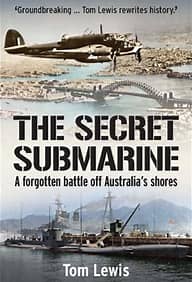
The Secret Submarine. By Tom Lewis. Big Sky Publishing, Sydney, 2025.
Reviewed by Walter Burroughs
The official history of the Royal Australian Air Force (RAAF) claims that no enemy submarines operating off the Australian coast during WWII were sunk. In this his latest book Tom Lewis suggests that the official history might have got it wrong and immerses his readers through an interesting piece of detection in explaining why.
There is an immense amount of detail in this work but it is easily read and should be of interest both to those less familiar with our wartime history and those from the warrior class who recall these now distant times. The author takes us into the design and operation of both submarines and anti-submarine aircraft even expanding into the lesser known but fascinating field of Australian wartime aircraft production.
This eventually leads to the nub of the story which details the happy hunting ground for enemy submarines off our most easterly point with the majority of shipping having to round Cape Byron. Accordingly, it was just south of here that the RAAF established a base at Coffs Harbour for flights of aircraft to patrol and escort convoys. This task usually fell to medium and light sized bombers such as the Ansons, Beauforts and Hudsons.
From ship attacks in early June 1943 enemy submarines were known to be in these waters and this was later confirmed from Japanese records. In a strategy to keep these craft at bay daytime patrols were conducted by Anson bombers and at dusk these patrols were handed over to radar-fitted Beauforts. Sometime at night the subs would have to surface to recharge their batteries and this is when they were most vulnerable.
On the 18th June one of three Beauforts conducting night patrols just after midnight had a radar blip and a few minutes later saw the outline of a submarine and immediately pressed an attack using three 250-pound depth charges. These exploded close to the boat which attempted to crash dive but for some reason was unable to completely submerge and lost speed. The Beaufort completed a turn and came in for second attack and dropped its last remaining depth charge just ahead of the submarine which was now fully surfaced and stopped in the water. The first Beaufort then retired to its base at Coffs Harbour but not before dropping a flare that illuminated the target for the other two Beaufort to take over.
The second Beaufort conducted further attacks with depth charges and machine guns and gun fire was returned by the submarine. Finally, the third Beaufort joined but was unable to locate the submarine. It is now up to the reader to find out what comes next and make a judgement call as to should the official history be challenged.
In summary this is a well-researched and well-written history of events during a critical stage of the Second World War when the enemy was still in the ascendency. It is full of facts and figures but is not overwhelming and there is something here of interest for everyone. The author is to be congratulated on keeping this important part of our history alive with an engrossing account before this soon fades from living memory.



